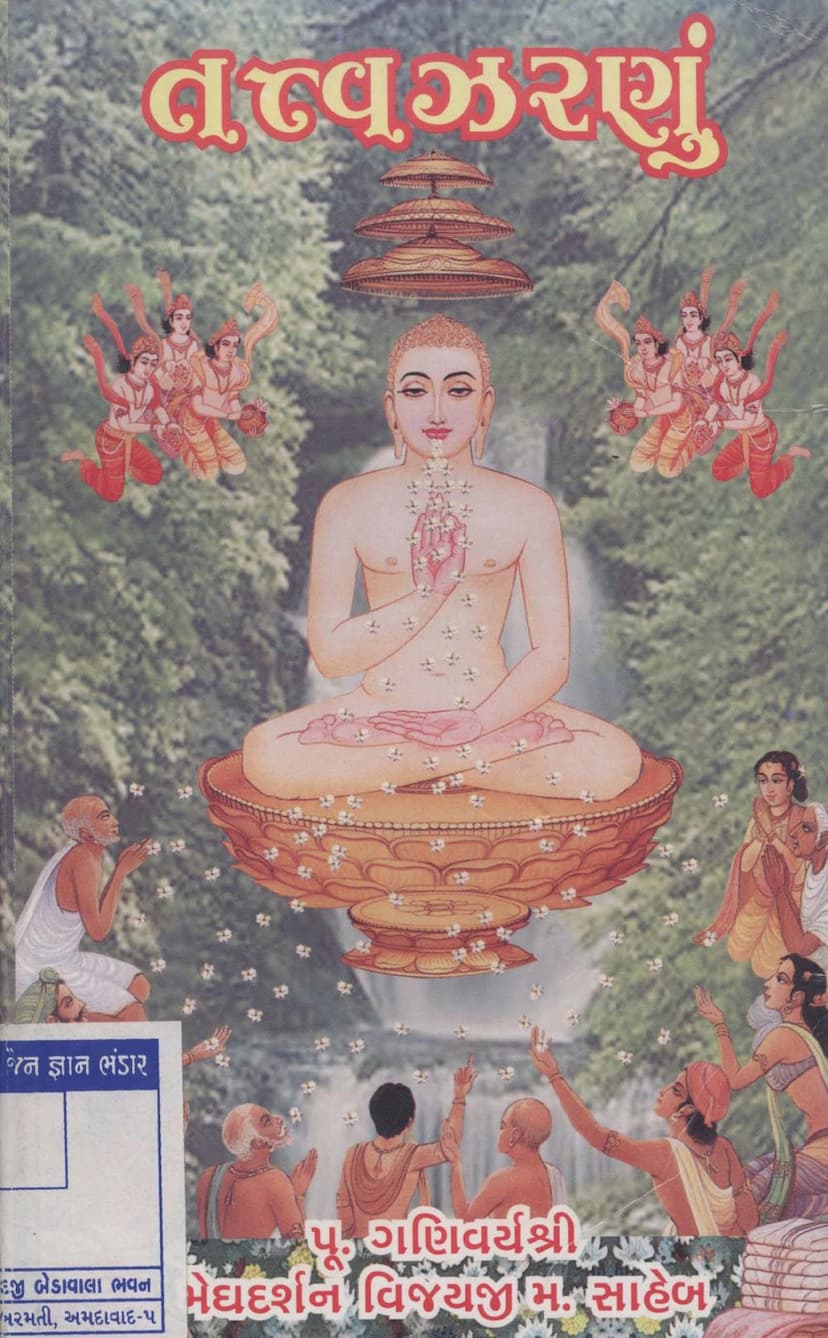Tattvazarnu
Added to library: September 2, 2025

Summary
This is a summary of the Jain text "Tattvazarnu" by Meghdarshanvijay, published by Vardhaman Sanskardham Mumbai. The text is a collection of discourses given by Ganivarya Shri Meghdarshanvijayji M. Sa., a disciple of Pt. Shri Chandrashekhar Vijayji M. Sa., during the Chaturmas of Samvat 2058 at the Shri Mahavirnagar Shvetambar Moortipujak Jain Sangh in Kandivali (West), Mumbai.
The book aims to provide a foundational understanding of Jain philosophy and its core principles in a simple language, as delivered in the early morning discourse series. The discourses cover various aspects of Jainism, focusing on the path to spiritual development and the ultimate goal of Moksha.
Here's a breakdown of the key themes and topics discussed, organized by general subject matter:
I. The Nature of Reality and the Soul:
- The Soul (Jiva): The text emphasizes the soul as the core of Jainism, distinct from the body. It is described as eternal, unchanging, and the central focus for spiritual progress. The concept of the soul's inherent qualities (like infinite knowledge, perception, bliss, and energy) being veiled by karma is discussed.
- Karma: A significant portion of the text delves into the intricacies of karma, its bondage, manifestation, and eventual eradication for liberation. The 158 types of karmas are discussed, categorizing them into ghati (destructive) and aghati (non-destructive) karmas. It highlights Mohaniya (delusion-producing) karma as the most significant obstacle to spiritual progress, followed by Gyanavarniya (knowledge-obscuring), Darshanavarniya (perception-obscuring), and Antaraya (obstacle) karmas. The text explains how actions, thoughts, and speech create karma, and how understanding karma is crucial for spiritual advancement.
- The Universe (Lokakash): The structure of the universe, consisting of Lokakash (inhabited realm) and Alokakash (uninhabited realm), is explained. The Lokakash is described as having a specific shape and being comprised of five main substances (astikayas): Jiva (soul), Pudgal (matter), Dharmastikay (medium of motion), Adharmastikay (medium of rest), and Akashastikay (space). The seven Narakas (hells), the celestial realms, and the human realm are situated within the Lokakash. The vastness and eternal nature of the soul and the universe are underscored.
- The Goal of Moksha: The ultimate aim of Jainism, Moksha, is presented as the state of complete liberation from karma, suffering, and the cycle of birth and death. It's described as the manifestation of the soul's pure and inherent qualities, leading to eternal bliss and omniscience.
II. Spiritual Practices and Principles:
- The Nine Fundamentals (Navatattva): While not explicitly listed as "Navatattva" in every section, the core concepts are woven throughout: Jiva (soul), Ajiva (non-soul), Punya (merit), Papa (demerit), Asrava (influx of karma), Samvara (cessation of karma), Nirjara (shedding of karma), Bandha (bondage of karma), and Moksha (liberation).
- The Importance of Understanding Truth (Samyak Darshan): The text repeatedly stresses the critical role of "Samyak Darshan" (Right Faith/Perception) – believing in the true nature of reality and the teachings of the Tirthankaras – as the first step towards spiritual progress. It explains how various types of Mithyatva (wrong belief) can hinder this realization.
- Conduct and Discipline (Achar and Virati): The discourses emphasize the need for ethical conduct and discipline. This includes abstaining from violence (Ahimsa), lying (Satya), stealing (Asteya), possessing excessively (Aparigraha), and sexual misconduct (Brahmacharya). The importance of vows (Vratas) and their stricter observance by monks and nuns (Samyam) is highlighted.
- The Role of Meditation and Devotion: The text touches upon the significance of meditation (Dhyana) and devotion (Bhakti) as tools for purifying the soul and progressing spiritually.
- The Path to Liberation: The discourses guide the listener on the path to Moksha, which involves the destruction of karma through right knowledge, right faith, and right conduct. The emphasis is on internal transformation rather than mere external rituals.
- The Fourfold Path (Chatuh-sharan): The text mentions the importance of taking refuge in the enlightened beings: Arihants, Siddhas, Acharyas, Upadhyayas, and Sadhus, as well as in the Jain Dharma itself.
- The Importance of the Guru: The guidance and blessings of a spiritual teacher (Guru) are considered essential for understanding and practicing the Jain path. The discourses mention the respect and devotion shown to Gurudevshri Meghdarshanvijayji M. Sa. and his own spiritual lineage.
III. Jain Cosmology and Life Principles:
- The Concept of "Anekantavada": The principle of "Anekantavada" (the doctrine of manifold aspects) is implicitly conveyed, suggesting that truth can be viewed from multiple perspectives and that rigid adherence to one viewpoint can be a form of "Aanabhigrahika Mithyatva" (non-discriminating wrong belief).
- Rebirth and Karma: The concept of karma is presented as the driving force behind the cycle of birth and death (Samsara). Actions in this life determine future births and experiences.
- The Three Jewels (Triratna): Although not explicitly enumerated in every discourse, the essence of Right Faith (Samyak Darshan), Right Knowledge (Samyak Gyan), and Right Conduct (Samyak Charitra) permeates the text as the path to liberation.
IV. The Impact of the Discourses:
The publication of these discourses into a book format is intended to allow for repeated study and reflection, helping individuals to sustain the positive life changes inspired by the discourses. The discourses are noted for their simplicity and effectiveness in transforming lives, leading to increased spiritual engagement, including participation in various rituals like Vihasthanak Tap and Attai. The text highlights the positive impact of the discourses on the spiritual life of the Mahavirnagar Jain Sangh.
V. The Author and Publisher:
The book is attributed to Meghdarshanvijay and published by Shri Mahavirnagar Shvet. Mu. Jain Sangh, Mumbai. The discourses were delivered by Pujyapada Ganivarya Shri Meghdarshanvijayji M. Sa. The publication is a testament to the dedicated efforts of the Sangh in spreading Jain teachings.
In essence, "Tattvazarnu" is a comprehensive spiritual guide that aims to illuminate the path of Jain philosophy, emphasizing self-realization, ethical living, and the ultimate goal of Moksha through the practical application of Jain principles.